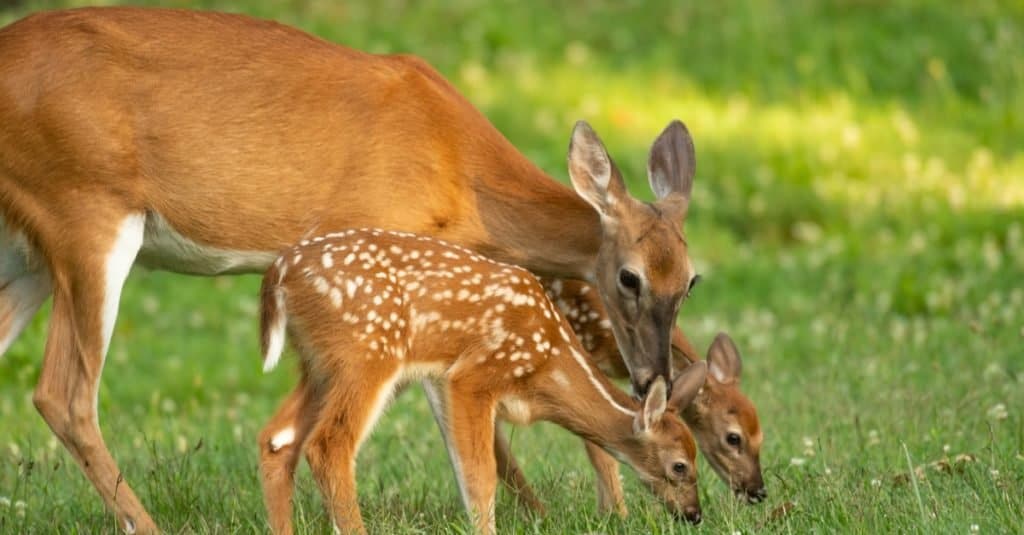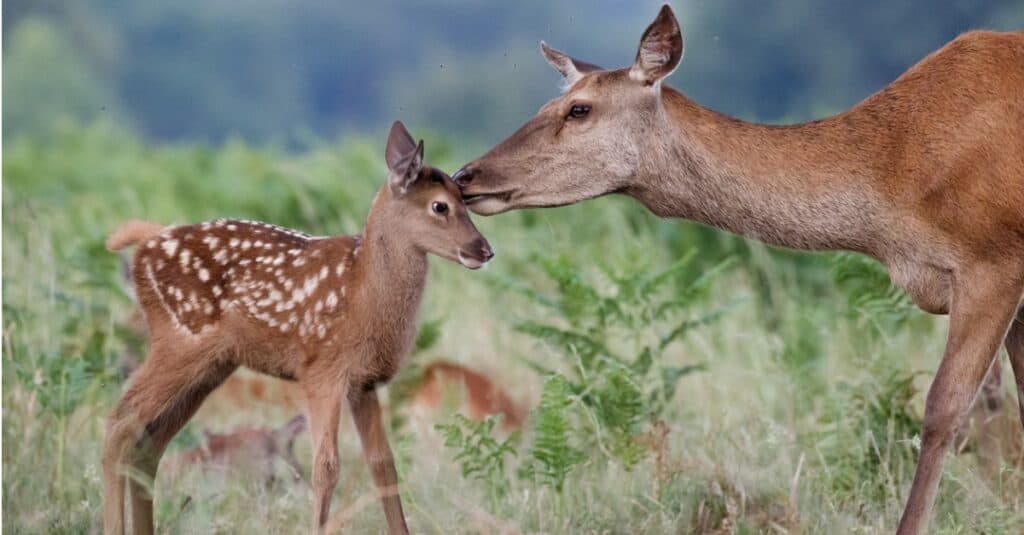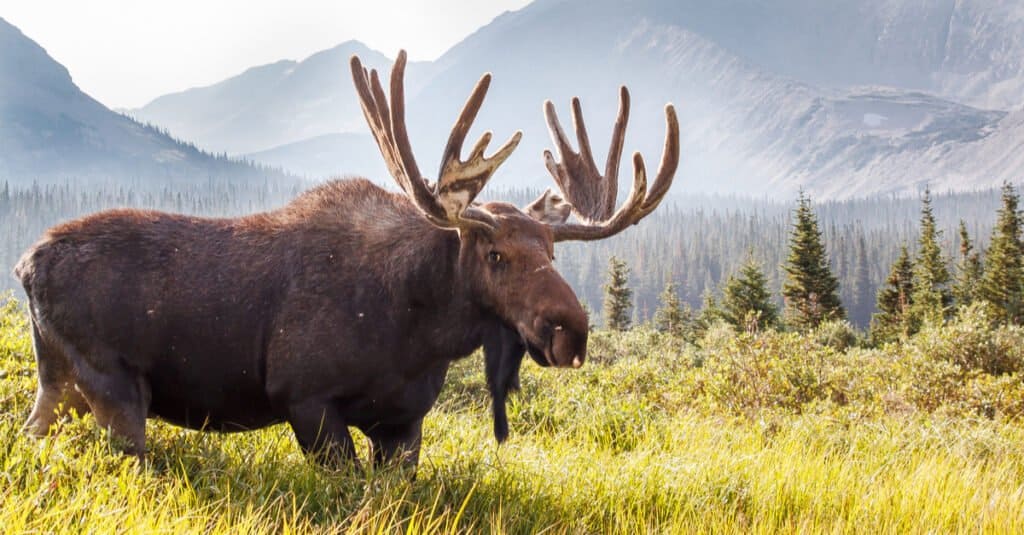Majestic deer antlers are one of the most iconic features of the animal world. These impressive head adornments have a large role to play in mating. While they’re used in combat with other males, a recent study showed that female deer tend to choose mates with larger antlers. The head ornamentation is reserved for the males in most deer species, aside from reindeer, who sport antlers, whether male or female. The water deer lacks this feature entirely, growing tusk-like canines instead. The deer family consists of forty-three species spread throughout much of the world. White-tailed deer are the most common species in North America and one of the most common in the world. With a focus on this species, when is deer mating season?
When is Deer Mating Season

Deer mating season occurs in autumn, with a peak in October.
©Jim Cumming/Shutterstock.com
Deer mating season takes place from late September to December, typically peaking in October. This is referred to as the ‘rut’, and occurs with the reduced sunlight and cooling temperatures of autumn when the days begin to shorten.
The seasonal shift triggers physiological changes in deer to prepare them for mating. Male deer, or bucks, experience a surge in testosterone. Females, called does, are stimulated to begin their phase of reproductive receptivity, estrus. White-tailed deer are prominent in the Americas. Their range extends from Southern Canada down through the northern areas of South America. In the more southern habitats, mating will occur in January or February.
Signs of Mating Season

Rubs and scrapes are environmental cues that breeding season has begun.
©Paul Tessier/Shutterstock.com
As the days grow shorter and the nights grow longer, signs of the rut can be seen. Rubs and scrapes are two of the most recognizable signs. Rubs occur when male bucks scrape against trees and shrubs, shedding a layer of velvet from their antlers. Velvet is the thin layer of living tissue that grows around their antlers in the spring and provides nourishment for the antlers. By breeding season, it’s not necessary and begins to shed. These rubs are also used to mark the buck’s territory. They secrete a musky scent from a gland at the base of their antlers that leaves a ‘signature’ on the rub. It communicates age, social rank and breeding status to others.
Scrapes appear several weeks later. These are bare patches of earth at the boundary of open areas and beneath low-hanging branches. The scrape process involves the buck chewing buds from branches and secreting scent from his forehead, preorbital and nasal glands onto the branches. It will paw at the ground underneath the branches creating a bare patch, and usually mark that spot by urinating. About two weeks before the peak of rut, bucks will make six to twelve scrapes for every hour they’re not resting.
Buck Behaviors
Like most deer species, white-tailed deer engage in a reproductive strategy called polygyny, in which a dominant male will have multiple female partners. However, the European Roe deer is a species that prefers monogamy, mating with only one partner.
Antler size is a strong predictor of reproductive success. Competition for mates can be fierce, so males will show displays of dominance to guard their territories and mates during the breeding season. Buck’s engage in incredible sparring matches with other males in competition for available mates. This is a time of singular focus; bucks will reduce food intake and increase their activity during rut. They use their bodies’ energy reserves to keep up with the chase of mating and lose weight during the season. According to information from the Deer Research Program at Caesar Kleberg Wildlife Institute, this can go too far at times and put bucks at risk of starvation if adequate food isn’t available after the rut.
The Does Decide

Does tend to play hard to get, evading the bucks in chase until they find the right dominant male to breed with.
©Tony Campbell/Shutterstock.com
White-tail does, like the females of most deer species, are polyestrous. They go into estrus for a 24 to 36 hour period every autumn. If she’s not bred in that timeframe, she’ll have another in 28 days. While the bucks are busy with impressive displays, dangerous sparring, and relentless pursuit, the does are deciding. A chase takes place where the buck will be met with retreat until the doe is ready. She will select which buck she’d like to mate with once she’s ready and receptive.
Birth to Fawns

Does give birth to one to three offsprings called fawns.
©shaftinaction/Shutterstock.com
Once mating occurs, pregnant female deer will go through a gestation period of six to eight months. They will give birth to one or two offspring after mating. Sometimes, three will be born. These baby deer are called fawns.
While the mother deer is out foraging, she’ll hide her young in nearby vegetation until they’re strong enough to walk independently. They’re often born with white spots that help provide camouflage from predators. Although weaned typically at two to five months, the young deer may stay with their mother for up to a year. Male deer generally take a minimal part in the raising of young. Females are therefore highly protective of their babies. They can be fierce if they believe their young ones to be threatened.
Other Deer Species that Mate in Autumn

Moose are solitary animals until the breeding season in autumn.
©Michael Liggett/Shutterstock.com
Red deers are a widespread species that live in Europe, the Americas, and Africa. During the rut, stags (males) compete for the attention of hinds (females) and defend the ones they attract. They have a loud and distinctive roar used to keep this harem together and to establish dominance with the other males. They will assess one another and engage in antler fights when necessary. Similar to the white-tailed deer, this species has a rut from late September through early November, peaking in October.
Moose, called elk in Europe, are the largest deer species on Earth. They are solitary animals aside from mating season. Scattered throughout the northern regions of North America and Eurasia, these deer also breed in autumn, with a peak rut of late September to early October. Elks are another large species, called wapiti in Europe. A name that comes from the Shawnee and Cree Native American word meaning ‘white rump.’ They breed in autumn, and in contrast to red deers roar, they send out a bugling call. At twilight, from early September through October, you can hear the bull elk bugle call out to promote their reproductive capacity to cow elk and show other males their dominance.
Deer Species Whose Season Differs

Sambar locks antlers in competition with other males.
©Sourabh Bharti/Shutterstock.com
Native to India and Southeast Asia, the sambar is the largest deer species in these regions. Males of this species spar like most deer locking antlers, but they also stand on their hind legs and crash themselves down upon one another. This is similar to the fighting techniques of bighorn sheep. Sambar deer can mate throughout the entire year, but they prefer September through January. The barasingha, or swamp deer, is native to the Indian subcontinent. During mating season, males will compete for females and try to gather harems of up to 30 females for one male. The mating season for this species occurs from September through April, with a peak in breeding activity from December to January. They are the only deer species that are monestrous, meaning that females come into heat only once per year.
The photo featured at the top of this post is © iStock.com/Karel Bock
Thank you for reading! Have some feedback for us? Contact the AZ Animals editorial team.






